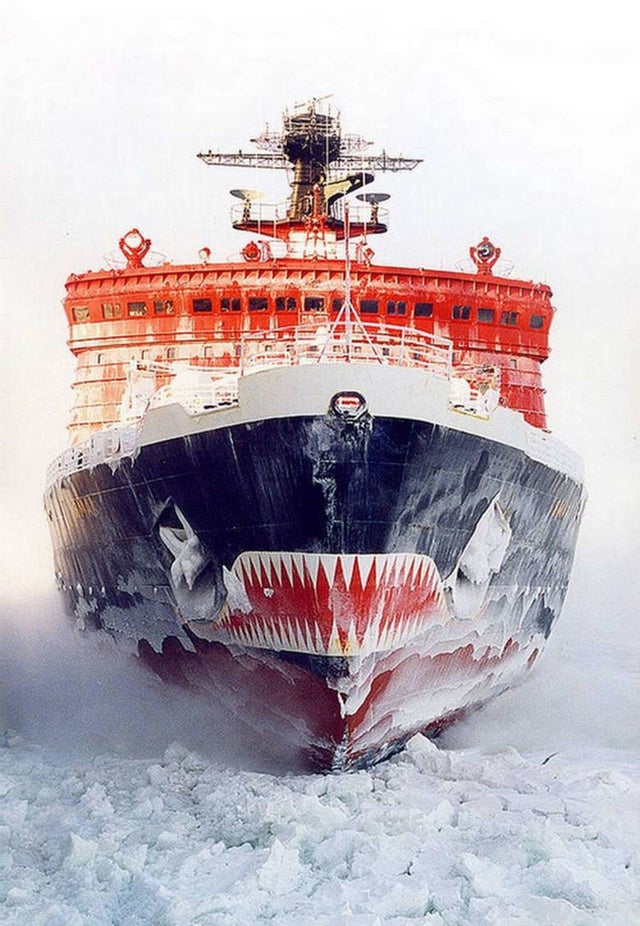As the child of a nuclear engineer, my fascination with nuclear-powered ships does not come as a surprise. Add to it the fact that my grandfather was named after the iconic Russian/Soviet icebreaker Krassin, and this is all the introduction I need for this brief homage to a noble breed that receives much less public attention than it deserves.
A child of the atomic age, the world’s first nuclear icebreaker, the Lenin, was launched on December 5, 1957 in the Soviet Union. Its main uses were keeping the Northeast Passage free, supplying goods to Northern Siberia, as well as for research. Twenty years later, the nuclear icebreaker Arktika, the successor of the Lenin, became the first surface vessel to reach the North Pole, previously accessible only to submarines. The end of the Cold War brought the first tourists to the North Pole on yet another Russian nuclear ice breaker, the Rossiya. But while all these beauties deserve attention and have their own stories to tell, no other nuclear icebreaker has captivated my imagination more than the Yamal.

Her keel was laid in 1986 in Leningrad (today’s St. Petersburg) at the Baltic Shipyard, a formidable institution which had produced many famous seagoing vessels in the decades before. However, with the collapse of the Soviet Union in between, the Yamal took six long years to complete. Named after Russia’s main Arctic industrial powerhouse, Yamal means “Earth’s end” in the indigenous Nenets language. The ship’s original purpose was to keep the Arctic shipping lanes free, but the political changes in the area reduced its role to a support and rescue vessel, as well as for North Pole expeditions.

Towering above the waterline with her painted black hull, white shark teeth, and red superstructure, the Yamal appears colder than the walls of ice she crushes through. 148 meters long, 30 meters wide, with displacement of 23,000 tons and maximum power of 75,000 hp, she is still one of the most powerful icebreakers in the world. The thick armor of steel houses two 171,000 kW nuclear reactors, of which only one is in operation at a time. The reactors supply the energy for the ship’s three electric motors, which in turn drive her three propellers. Eighty-six sensors, distributed all over the ship, monitor the radioactivity on board around the clock.

As in some Russian fairy tale, she is forever bound to reign the northern seas – the Yamal uses Arctic sea water to cool her nuclear reactors, making it impossible to move her to Antarctica due to the warm tropical waters around the equator. But with fresh fuel rods, she can patrol her kingdom of ice for five years without having to call at a port.

The ship has a double outer shell, reaching a thickness of 48 mm at the points regularly in contact with the ice. Using her own weight, the Yamal is designed to break ice up to five meters thick but has occasionally had to force her way through nine-meter slabs. The reinforced bow of the ship moves on top of the ice, the ice layer splitting under the weight. A special hull-coating made of polymer reduces friction, and the ballast water between the two hull layers is moved around to assist the breaking of the ice. If necessary, large nozzles at the bow below the waterline support the process, ejecting up to six cubic meters of hot water per second to soften the ice. The Yamal is also capable of breaking ice while moving backwards.

At the time of writing, the ship has reached the North Pole 47 times, more than earning her reputation as one of the safest passenger vessels to explore the Arctic. She is also the most comfortable, her rugged façade hiding unexpected luxuries. The Yamal is equipped with a gymnasium, a basketball court, a sauna, and a swimming pool for those who wish to stay active while on board. There is also a library, a lounge, a dining hall, and an infirmary. A crew of 189 takes care of only 50 passenger cabins – a rather cozy and intimate experience in comparison to today’s overcrowded cruise ships.
Whether it is her daunting shark-looks or her impressive technical abilities, the Yamal remains one of the most exciting nuclear ships in service. One I would gladly sail on. One day.
Check out some more cool pictures of the Yamal below! See you next week!
The Shipyard






